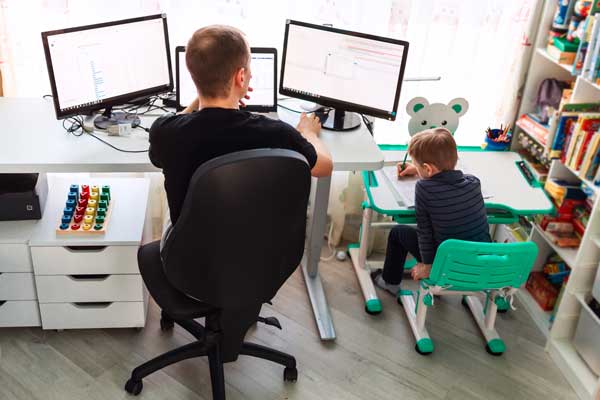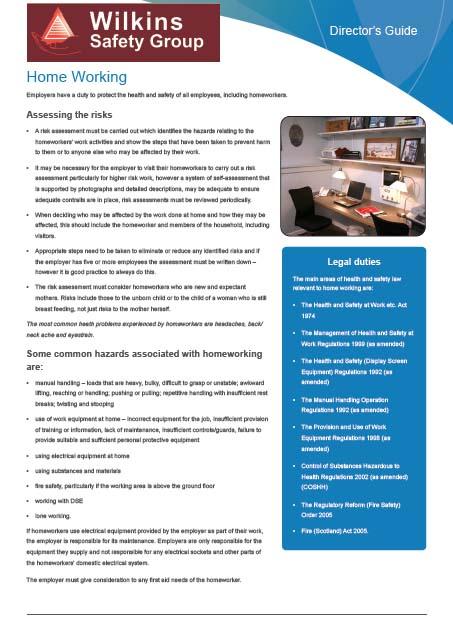Employers have a duty to protect the health and safety of all employees, including homeworkers.
Assessing the risks of home working
- A risk assessment must be carried out which identifies the hazards relating to the homeworkers’ work activities and show the steps that have been taken to prevent harm to them or to anyone else who may be affected by their work.
- It may be necessary for the employer to visit their homeworkers to carry out a risk assessment particularly for higher risk work, however a system of self-assessment that is supported by photographs and detailed descriptions, may be adequate to ensure adequate contrails are in place, risk assessments must be reviewed periodically.
- When deciding who may be affected by the work done at home and how they may be affected, this should include the homeworker and members of the household, including visitors.
- Appropriate steps need to be taken to eliminate or reduce any identified risks and if the employer has five or more employees the assessment must be written down – however it is good practice to always do this.
- The risk assessment must consider homeworkers who are new and expectant mothers. Risks include those to the unborn child or to the child of a woman who is still breast feeding, not just risks to the mother herself.
The most common heath problems experienced by homeworkers are headaches, back/neck ache and eyestrain.
Some common hazards associated with homeworking are:
- manual handling – loads that are heavy, bulky, difficult to grasp or unstable; awkward lifting, reaching or handling; pushing or pulling; repetitive handling with insufficient rest breaks; twisting and stooping
- use of work equipment at home – incorrect equipment for the job, insufficient provision of training or information, lack of maintenance, insufficient controls/guards, failure to provide suitable and sufficient personal protective equipment
- using electrical equipment at home
- using substances and materials
- fire safety, particularly if the working area is above the ground floor
- working with DSE
- lone working.
If homeworkers use electrical equipment provided by the employer as part of their work, the employer is responsible for its maintenance. Employers are only responsible for the equipment they supply and not responsible for any electrical sockets and other parts of the homeworkers’ domestic electrical system.
The employer must give consideration to any first aid needs of the homeworker.
If you work from home, your employer must make sure there is a risk assessment of your work activities. This may involve someone visiting you or it may involve you completing a questionnaire and providing appropriate evidence e.g. photographs. It will help decide if sufficient steps have been taken to prevent harm to you or anyone else who may be affected by your work.
“If your employer provides any control measures you must use them properly”
“If your employer provides any control measures you must use them properly”
What are your responsibilities?
If you use electrical equipment provided by your employer as part of your work, your employer is responsible for its maintenance. They are not responsible for electrical sockets and other parts of your domestic electrical system, these are your responsibility. It is also recommended that you carry out the following basic checks on a regular basis:
- electrical equipment is turned off before it is checked
- plugs are not damaged
- the outer cover of the equipment is not damaged, for example look for loose parts or screws
- leads, wires or cables do not have damage to the outer covering
- there are no burn marks or staining that suggests overheating
- there are no trailing wires.
If electrical equipment is damaged, faulty or dangerous, you should notify your employer so that repairs or replacements can be made.
If your employer provides any control measures you must use them properly. For example, you may be provided with a stand for your laptop computer, personal protective equipment, or even a procedure to be followed. You have a legal duty to use these controls as you have been instructed.
If you habitually used display screen equipment (DSE) as part of your work, you will be entitled to an eye test and you should also have a workstation assessment which may be undertaken by questionnaire. Your employer must provide you with information on how to obtain this.
If you have any concerns about the safety of your home working arrangements, you should speak to your employer or manager.
Home workers should notify their employer of any accidents or incidents that occur whilst they are working. In some case, the employer will provide the employee with a first aid kit, dependent on the work activities.

Legal duties
The main areas of health and safety law relevant to home working are:
- The Health and Safety at Work etc. Act 1974
- The Management of Health and Safety at Work Regulations 1999 (as amended)
- The Health and Safety (Display ScreenEquipment) Regulations 1992 (as amended)
- The Manual Handling Operation Regulations 1992 (as amended)
- The Provision and Use of Work Equipment Regulations 1998 (as amended)
- Control of Substances Hazardous to Health Regulations 2002 (as amended) (COSHH)
- The Regulatory Reform (Fire Safety) Order 2005
- Fire (Scotland) Act 2005

